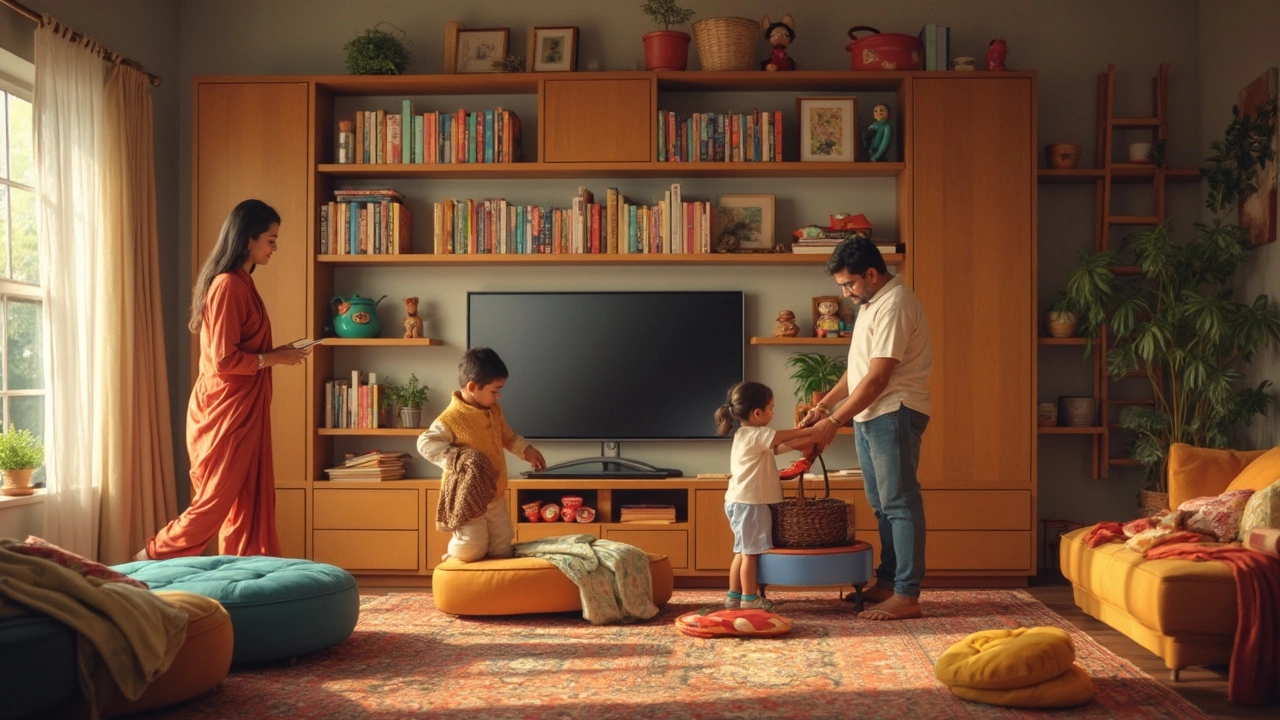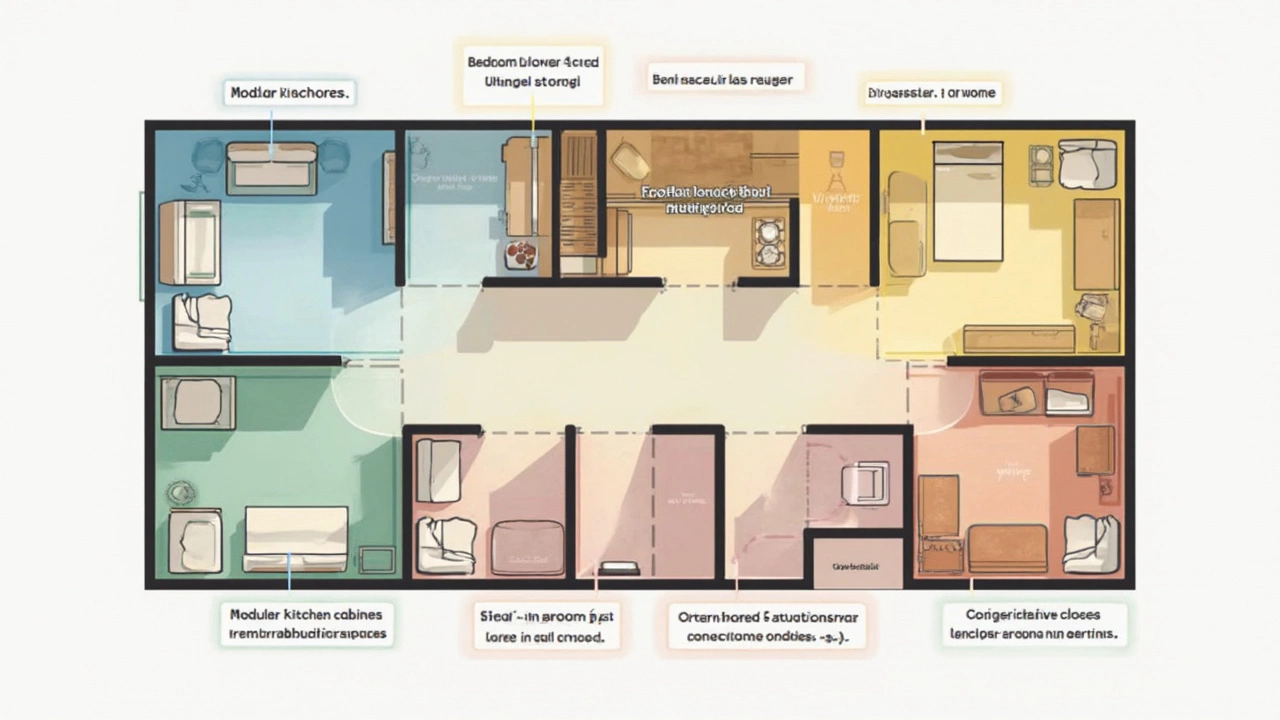Home Storage Percentage: How Much Storage Space Do You Really Need?

Ever feel like your home is a closet with a kitchen attached? You’re not the only one hunting for the perfect balance between living space and storage. Most pros shoot for about 10% of your home’s square footage dedicated to storage. That means if you’re in a 2,000 square foot house, about 200 square feet is ideal for storing stuff—from winter coats to holiday lights. But real life isn’t built on perfect formulas.
I’ve seen families with two kids (my own included) stuff every extra inch with hockey gear, craft supplies, and an embarrassing collection of half-finished DIY projects. How much storage you actually need can depend on your hobbies, your habits, and whether you’re willing to let go of things you swear you’ll use “someday.”
- Cracking the Magic Storage Number
- Room-by-Room Storage Breakdown
- Smart Storage: Tricks from Everyday Life
- Balancing Storage with Living Space
Cracking the Magic Storage Number
So, what’s the golden rule for how much of your home should be storage? Experts like the National Association of Home Builders say that storage should take up about 10% to 15% of your total square footage. Go much higher and you’re living in a warehouse; go lower and you’re out of luck when it comes to finding your umbrella on a rainy morning.
If you want a quick-glance idea of what this breaks down to, check out this table:
| Home Size (sq ft) | Ideal Storage (sq ft) |
|---|---|
| 1,000 | 100–150 |
| 1,500 | 150–225 |
| 2,000 | 200–300 |
| 2,500 | 250–375 |
| 3,000 | 300–450 |
This isn’t just about closets and basements either. Storage means everything from kitchen pantries to mudroom cubbies to that space under your stairs you wish had a door. Even garages count—though I’d argue bikes and camping gear don't belong where cars are supposed to go (don’t tell Jax that, though; his scooter is parked there right now).
Most folks underestimate how much storage they use—and overstuff what little they have. The home storage sweet spot can change if you’re working from home, have big hobbies, or live with packrats (kids are pros at this). It’s less about hitting an exact number and more about being real with your stuff versus your square footage. Ask yourself: if you had 15% storage, would you just pile more junk, or finally find space for what you actually use?
Room-by-Room Storage Breakdown
Not all rooms swallow stuff at the same rate. Big difference between what you’d stash in the kitchen and what’s hiding in the garage, right? Let’s look at the average storage space each room eats up, plus where clutter tends to pile up.
If you ever wondered what experts suggest, here’s a quick peek:
| Room | Suggested Storage % of Room | Common Storage Items |
|---|---|---|
| Bedroom | 12-15% | Clothes, shoes, bedding, personal items |
| Kitchen | 15-20% | Pantry items, cookware, appliances |
| Living Room | 5-8% | Games, books, electronics, toys |
| Bathroom | 8-10% | Towels, toiletries, cleaning products |
| Garage/Basement | 40-50% | Tools, seasonal gear, bulk storage |
| Entryway | 6-10% | Shoes, coats, bags, umbrellas |
The home storage sweet spot shifts, depending on your lifestyle and how much you hoard or purge. For example, my daughter Eliana fills every inch of her closet with art supplies, while my son Jax only needs a couple of drawers for his epic sneaker rotation.
Here’s a quick run-through with some doable ideas for each room:
- Bedrooms: Built-ins work magic. Under-bed drawers, double-hanging rods, and over-door hooks keep daily mess at bay.
- Kitchens: Pull-out shelves and labeled bins in pantries make it easier to see what you have. Hang pots and pans if you’re tight on cabinets.
- Living Rooms: Choose coffee tables with storage inside. Wall-mounted shelves hold books and games without eating up floor space.
- Bathrooms: Use stackable organizers in cabinets, and don’t underestimate the back of the door for towel racks.
- Garage/Basement: Go vertical. Wall systems and ceiling racks free up the floor. Pegboards help you see tools, not lose them.
- Entryways: Baskets and cubbies are a lifesaver. Hooks at kid height make it easy for everyone to drop bags and jackets where they belong.
Making every room pull its weight cuts back on random piles and makes cleaning up faster (especially when you’ve got two kids rushing out the door bright and early).

Smart Storage: Tricks from Everyday Life
If you’ve ever hunted for a lost soccer cleat at the bottom of a pile of stuff, it’s clear that clever storage isn’t just nice to have—it’s essential. Real life throws stuff at us constantly. Kids bring home art projects. Winter brings boots and gloves. Suddenly, your closets are bursting.
What works? For starters, the vertical space most people ignore. Hang shelves near the ceiling in laundry rooms, garages, or even kid bedrooms for bins you only need to reach now and then. Over-the-door organizers aren’t just for shoes—Jax uses one on his closet door for LEGO sets, and it’s a game changer.
Think about the furniture already in your home. If it can hold stuff, make it do double duty. Ottomans with hidden storage, beds with built-in drawers, and benches that open up are perfect for tossing blankets, toys, or off-season clothes out of sight. In smaller houses, this swap adds real breathing room—fast.
Another easy win: labeling clear plastic bins. When things are visible and labeled, everyone’s more likely to put stuff back where it belongs. It’s boring advice, but it actually works. We started with the pantry, labeling snacks and lunch supplies, and now even my youngest, Eliana, can find her lunchbox in the morning rush.
- Use the backs of closet doors for extra hooks or small baskets.
- Install shelving above door frames for bonus space (great for storing board games or photo albums).
- Divide drawers with simple organizers. You’ll fit more, and it won’t turn into a jumble.
- Store holiday decorations or out-of-season gear under the stairs, if you’ve got them. That awkward spot under the steps is a storage goldmine.
One more thing: don’t be afraid to let things go. If something hasn’t earned its spot in your limited storage, donate it or kick it to the curb. Smart storage in real life is less about squeezing more in, and more about knowing what’s worth keeping around in the first place. That’s the secret behind home storage that actually works for your family, not just against your sanity.
Balancing Storage with Living Space
Nailing the right balance between storage and actual living space is tricky, especially once you throw kids into the mix. According to the National Association of Home Builders, homeowners often regret dedicating too much square footage to storage areas at the expense of open living space. Too many closets or bulky cabinets can eat up the usable room for family hangouts, hobbies, or just stretching your legs.
The sweet spot for home storage is making it feel almost invisible—it’s there when you need it, but it doesn’t steal the show. Try these practical tricks for keeping storage in check without turning your living room into a garage:
- Go vertical: Use tall shelving, stackable bins, and over-door organizers. This way, storage climbs the walls instead of swallowing up your floors.
- Pick dual-purpose furniture: Storage ottomans, beds with drawers underneath, and coffee tables with hidden space are lifesavers in smaller homes.
- Purge regularly: Make decluttering a habit. Set a schedule—maybe twice a year with the changing seasons—to toss, donate, or store out-of-season stuff in harder-to-reach spots.
- Designate storage zones: Don’t let storage snake its way into every room. Decide where stuff should live, and stick to it.
It helps to get a picture of how things break down. Here’s a look at a typical family home (2,000 sq ft) and how storage space might be carved out. Experts recommend keeping storage to about 10% of your total space, including closets, cabinets, and the garage.
| Home Area | Ideal Storage Size (sq ft) | What’s Usually Stored |
|---|---|---|
| Entry Closet | 12 | Coats, shoes, backpacks |
| Kitchen Pantry | 20 | Food, small appliances |
| Bedroom Closets | 60 | Clothes, linens |
| Laundry/Utility | 20 | Cleaning supplies, seasonal gear |
| Garage/Basement | 80 | Sports equipment, tools, bikes |
| Other Cabinets/Shelves | 8 | Kids’ art, books, games |
Notice how storage is spread out—not lumped all in one spot. When you’re designing or reorganizing your home, watch for the trade-off: more storage usually equals less open space for the stuff that really matters, like family time. If you’re on the fence, lean toward flexible storage you can expand or shrink depending on needs. Worst-case, you’ll have fewer places for clutter to hide—and more room for life to happen.